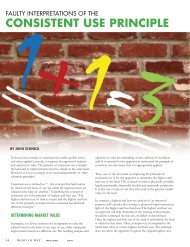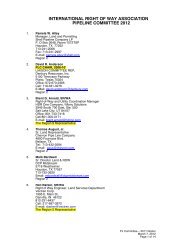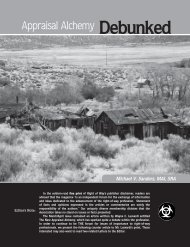Rodolfo J. Aguilar, Ph.D., ASA, GAA - International Right of Way ...
Rodolfo J. Aguilar, Ph.D., ASA, GAA - International Right of Way ...
Rodolfo J. Aguilar, Ph.D., ASA, GAA - International Right of Way ...
Create successful ePaper yourself
Turn your PDF publications into a flip-book with our unique Google optimized e-Paper software.
DOOR ADVERTISING BILLBOARDS<br />
An on-slaught <strong>of</strong> articles on the appraisal <strong>of</strong> billboard structures has recently hit the<br />
academic-trade press 1, 2, 3 . The acknowledged “bible” <strong>of</strong> billboard appraisal is the<br />
textbook by Donald T. Sutte, Jr., The Appraisal <strong>of</strong> Outdoor Advertising Signs 4 ,<br />
published by the Appraisal Institute in 1994 5 . Since its publication, praises and<br />
vituperations have been showered on Sutte’s textbook. In my opinion, Sutte’s<br />
theory and conclusions are correct and valid, and fairly outline a logical approach to the<br />
valuation <strong>of</strong> <strong>of</strong>f-site outdoor advertising structures. However, one must not forget that the<br />
purpose <strong>of</strong> an appraisal is to develop the most reasonable estimate <strong>of</strong> the price (in terms<br />
<strong>of</strong> money) that a willing buyer would pay a willing seller as full compensation for the<br />
seller’s property, that is, its market value. In the case <strong>of</strong> a billboard, the property rights<br />
appraised are the fee simple interest in the structure, usually located on leased land, i.e.,<br />
a leasehold, the land lease, and the permits.<br />
On-Premise Versus Off-Premise Advertising<br />
On-premise and <strong>of</strong>f-premise signs are defined as follows:<br />
On-premise Signs. Any sign that disseminates information that directly relates to the<br />
use <strong>of</strong> the property on which it is located and is not a separate and distinct use.<br />
Off-premise Outdoor Advertising encompasses any out-door sign, display, figure,<br />
painting, drawing, message, plaque, poster, billboard, or any other thing which is<br />
designed, intended or used to advertise or inform, any part <strong>of</strong> which advertising or<br />
information content is visible from any place on the main travel way <strong>of</strong> the interstate<br />
system or any thoroughfare. The term “<strong>of</strong>f-premise outdoor advertising,” however,<br />
does not include signs advertising or identifying on-premise activities, and such<br />
on-premise advertising or identifying structures shall not be considered “outdoor<br />
advertising” structures for any purpose.<br />
The purpose <strong>of</strong> this article is to clarify and revisit the methods by which the market<br />
value <strong>of</strong> <strong>of</strong>f-premise outdoor advertising structures is estimated.<br />
The Plant<br />
It is not uncommon for an outdoor advertising company to have an <strong>of</strong>fice and main<br />
shop facility in addition to its investment in the sign structures. The sign structures are<br />
commonly referred to in the industry as “The Plant.” The plant consists only <strong>of</strong> the sign<br />
structures (the five basic types <strong>of</strong> advertising signs described below) which are normally<br />
located on leased sites. The plant does not include the company <strong>of</strong>fice(s) and main shop<br />
facility.<br />
General Classification <strong>of</strong> Outdoor Advertising Structures<br />
Outdoor advertising structures are generally classified as:<br />
1. Permanent Paints. These structures frequently differ in size, shape and income.<br />
Usually, they have fixed term contracts for the advertising<br />
space. The message is permanently painted or printed on the<br />
physical substrate face <strong>of</strong> the sign or on a vinyl.<br />
2. Rotary Bulletins. These signs have consistent face sizes<br />
with varying types <strong>of</strong> structures. The advertising copy is<br />
painted on panels or printed on vinyl, which are rotated<br />
or moved between several locations at frequent intervals<br />
during the term <strong>of</strong> the contract with the advertiser. The<br />
standard size <strong>of</strong> rotary bulletins is 14 feet by 48 feet, and<br />
may include cutouts or embellishments.<br />
PHOTOGRAPHY BY MARGARET SISON
















